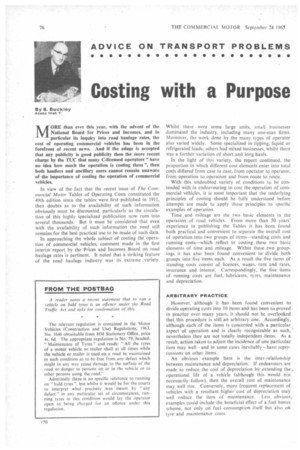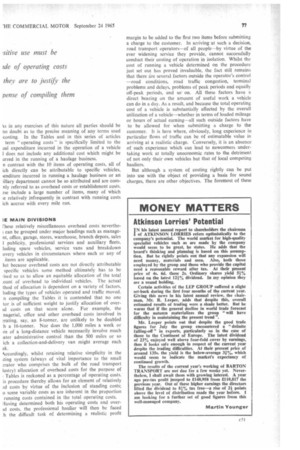Costing with a Purpose
Page 78

Page 79

Page 80

If you've noticed an error in this article please click here to report it so we can fix it.
MORE than ever this year, with the advent of the National Board for Prices and Incomes, and in particular its inquiry into road haulage rates, the cost of operating commercial vehicles has been in the forefront of recent news. And if the adage is accepted that any publicity is good publicity then the more recent charge by the TUC that many C-licensed operators "have no idea how much the operation is costing them ", then both hauliers and ancillary users cannot remain unaware of the importance of costing the operation of commercial vehicles.
In view of the fact that the recent issue of The Commercial Motor Tables of Operating Costs constituted the 49th edition since the tables were first published in 1911, then doubts as to the availability of such information obviously must be discounted, particularly as the circulation of this highly specialized publication now runs into several thousands. But it must be considered that even with the availability of such information the need still remains for the best practical use to be made of such data.
In approaching the whole subject of costing the operation of commercial vehicles, comment made in the first interim report by the Prices and Incomes Board on road haulage rates is pertinent. It noted that a striking feature of the road haulage industry was its extreme variety.
Whilst there were some large units, small businesses dominated the industry, including many one-man firms. Moreover, the work done by the many types of operator also varied widely. Some specialized in tipping, liquid or refrigerated loads; others had mixed businesses, whilst there was a further variation of short And long hauls.
In the light of this variety, the report continued, the proportion in which different cost elements enter into total costs differed from case to case, from operator to operator, from operation to operation and from route to route.
With this undoubted variety of conditions to be contended with in endeavouring to cost the operation of commercial vehicles, it is most important that the underlying principles of costing should be fully understood before attempts are made to apply those principles to specific examples of operation.
Time and mileage are the two basic elements in the operation of road vehicles. From more than 50 years' experience in publishing the Tables it has been found both practical and convenient to separate the overall cost of operation into two groups of items—standing costs and running costs—which reflect in costing these two basic elements of time and mileage. Within these two groupings it has also been found convenient to divide both groups into five items each. As a result the five items of standing costs consist of licences, wages, rent and rates, insurance and interest. Correspondingly, the five items of running costs are fuel, lubricants, tyres, maintenance and depreciation.
ARBITRARY PRACTICE
However, although it has been found convenient to divide operating costs into 10 items and has been so proved in practice over many years. it should not be overlooked that this procedure is still an arbitrary one. Accordingly, although each of the items is concerned with a particular aspect of operation and is clearly recognizable as such," nevertheless they are not totally independent items. As a result, action taken to adjust the incidence of one particular item may well and in some cases inevitably have repercussions on other items.
An obvious example here is the inter-relationship between maintenance and depreciation. If endeavours are made to reduce the cost of depreciation by extending the. operational life of a vehicle (although this would not necessarily follow), then the overall cost of maintenance may well rise. Conversely, more frequent replacement of vehicles with a resultant higher cost of depreciation may well reduce the item of maintenance. Less obvious, examples could include the beneficial effect of a fuel bonus scheme, not only on fuel consumption itself but also on tyre and maintenance costs. ks in any exercises of this nature all parties should be no doubt as to the precise meaning of any terms used costing. In the Tables and in this series of articles
term "operating costs " is specifically limited to the cal expenditure incurred in the operation of a vehicle I does not include any additional cost which might be erred in the running of a haulage business.
n contrast with the 10 items of operating costs, all of ich directly can be attributable to specific vehicles, enditure incurred in running a haulage business or an :illary department cannot be so attributed and are cornnly referred to as overhead costs or establishment costs. :se include a large number of items, many of which ;e relatively infrequently in contrast with running costs ich accrue with every mile run.
IE MAIN DIVISIONS
Ehese relatively miscellaneous overhead costs neverthe; can be grouped under major headings such as managent, office, garage, stores, warehouse, branch depots, sales publicity, professional services and auxiliary fleets. luding spare vehicles, service vans and breakdown overy vehicles in circumstances where each or any of items are applicable.
lut because overhead costs are not directly attributable specific vehicles some method ultimately has to be rised so as to allow an equitable allocation of the total ount of overhead to individual vehicles. The actual thod of allocation is dependent on a variety of factors, luding the types of vehicles operated and traffic moved.
n compiling the Tables it is contended that no one tor is of sufficient weight to justify allocation of overid costs on that score alone. For example, the nagerial, office and other overhead costs involved in !rating, say, an 8-tonner, are unlikely to be doubled h a 16-tonner. Nor does the 1,000 miles a week or ,re of a long-distance vehicle necessarily involve much .ater administrative control than the 500 miles or so ich a collection-and-delivery van might average each ek.
Nccordingly, whilst retaining relative simplicity in the aing system (always of vital importance to the small :rator who comprises the bulk of the road transport lustry) allocation of overhead costs for the purpose of Tables is reckoned as a percentage of operating costs. is procedure thereby allows for an element of relatively ad costs by virtue of the inclusion of standing costs: o some variable costs as are inherent in the proportion running costs contained in the total operating costs, hlaving determined both his operating costs and overid costs, the professional haulier will then be faced h the difficult task of determining a realistic profit margin to be added to the first two items before submitting a charge to the customer. In arriving at such a decision, road transport operators—of all people—by, virtue of the ever widening service they provide, cannot successfully conduct their costing of operation in isolation. Whilst the cost of running a vehicle determined on the procedure just set out has proved invaluable, the fact still remains that there tire several factors outside the operator's control —road conditions, road traffic congestion, terminal problems and delays, problems of peak periods and equally off-peak periods, and so on. All these factors have a direct bearing on the amount of useful work a vehicle can do in a day. As a result, and because the total operating cost of a vehicle is substantially affected by the overall utilization of a vehicle—whether in terms of loaded mileage or hours of actual earning—all such outside factors have to be allowed for when submitting a charge to the customer. It is here where, obviously, long experience in particular flows of traffic can be of estimatable value in arriving at a realistic charge. Conversely, it is an absence of such experience which can lead to newcomers undertaking work at totally uneconomic rates to the detriment of not only their own vehicles but that of local competing hauliers.
But although a system of costing rightly can be put into use with the object of providing a basis for sound charges, there are other objectives. The foremost of these
is to provide a yardstick by which to measure current efficiency. Obviously, however, that exercise must not stop there but must also lead to examination and subsequent adoption of more efficient ways of operating in the future.
As rightly stressed in the Prices and Incomes Board's report, there is a wide variety in types of operation and this may even apply within a single fleet. Obviously, in such cases, some grouping of vehicle coatings must be undertaken before useful and practical yardsticks can be derived. In this context it is pertinent to stress that there can be a misuse of the word " average " and its subsequent application in costing. This is necessary to level out extremes so as to arrive at a realistic figure for general application, but such a procedure has only practical use within specific groups.
Whilst it is virtually self-evident that a fuel consumption average for an entire fleet ranging, possibly, from 5-toriners to maximum-load multi-wheelers would have little or no mea`ning, defining the groups within which the derivation of an average figure (whether it be indicative of fuel consumed, mileage run or traffic carried) would be of genuine value, calls for experience and judgment. In a large and mixed fleet the danger of setting up too many groups and so complicating the system unduly has to be guarded against.
It is essential that specific objectives should be laid down before selecting and putting into operation a system of costings for commercial vehicles appropriate to particular circumstances. But even in the proces& of compiling such information, and before the final results are obtained, much useful allied information may come to light for the first time. Pertinent questions as to why existing procedures have been conducted in the manner in which they have may reveal hidden inefficiencies and, particularly likely, hidden subsidence as between one department and another. In the process of applying a costing system, staff at all levels, obviously aware of its introduction, may well become more cost-conscious themselves in approaching their particular duties to the benefit of the business as a whole.
























































































































